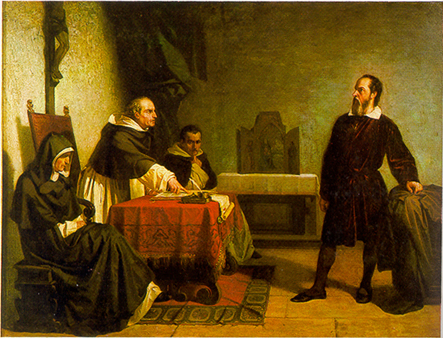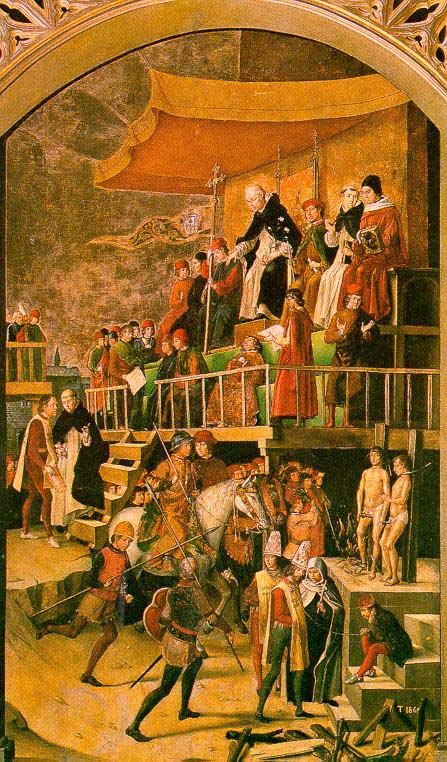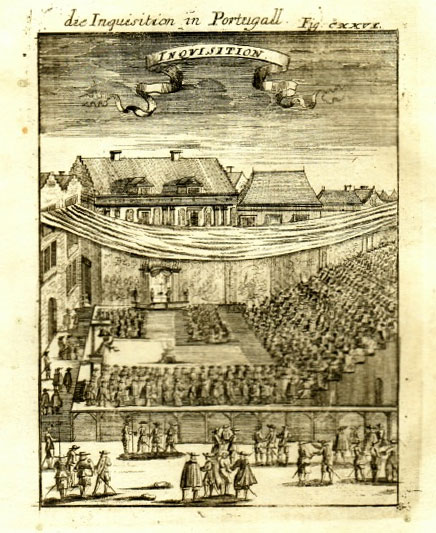|

from
Wikipedia Website

Galileo facing the
Roman Inquisition
The term Inquisition can refer to any
one of several institutions charged with trying and convicting
heretics within the
Roman Catholic Church and sometimes other
offenders against canon law.
It may refer to:
-
an ecclesiastical tribunal
-
the institution of the Roman
Catholic Church for combating or suppressing heresy
-
a number of historical
expurgation movements against heresy (orchestrated by the
Roman Catholic Church)
-
the trial of an individual
accused of heresy.
Inquisition tribunals
and institutions
Before the 12th century, the Western Christian Church already
suppressed what it saw as heresy, usually through a system of
ecclesiastical proscription or imprisonment, but rarely resorting to
torture or executions as this form of punishment had many
ecclesiastical opponents, although some non-secular countries
punished heresy with death penalty.
In the 12th century, in order to counter the spread of
Catharism, prosecutions against heresy became more
frequent. The Church charged councils composed of bishops and
archbishops with establishing inquisitions.
In the 13th century, Pope Gregory IX (reigned 1227-1241) assigned
the duty of carrying out inquisitions to the Dominican Order.
Inquisitors acted in the name of the Pope and with his full
authority. They used inquisitorial procedures, a legal practice
commonly used at the time. They judged heresy alone, using the local
authorities to establish a tribunal and to prosecute heretics. After
the end of the fifteenth century, a Grand Inquisitor headed each
Inquisition.
Inquisition in this way persisted until the
19th century.
In the 16th century, Pope Paul III established a system of
tribunals, ruled by the "Supreme Sacred Congregation of the
Universal Inquisition", and staffed by cardinals and other Church
officials. This system would later become known as the Roman
Inquisition. In 1908 Pope Pius X renamed the organization: it became
the "Supreme Sacred Congregation of the Holy Office".
This in its turn became the
Congregation for the Doctrine of the Faith
in 1965, which name continues to this day.
Purpose
A
1578 handbook for inquisitors
spelled out the purpose of inquisitorial penalties:
... quoniam punitio non refertur
primo & per se in correctionem & bonum eius qui punitur, sed in
bonum publicum ut alij terreantur, & a malis committendis
avocentur.
[Translation from the Latin: "...
for punishment does not take place primarily and per se for the
correction and good of the person punished, but for the public
good in order that others may become terrified and weaned away
from the evils they would commit."]
Historic Inquisition
movements
Historians distinguish between four different manifestations of the
Inquisition:
-
the Medieval Inquisition (1184-
)
-
the Spanish Inquisition
(1478-1834)
-
the Portuguese Inquisition
(1536-1821)
-
the Roman Inquisition (1542-
~1860 )
Because of its objective — combating
heresy — the Inquisition had jurisdiction only over baptized members
of the Church (which, however, encompassed the vast majority of the
population in Catholic countries). Secular courts could still try
non-Christians for blasphemy. (Most of the witch trials went through
secular courts.)
Different areas faced different situations with regard to heresies
and suspicion of heresies. Most of Medieval Western and Central
Europe had a long-standing veneer of Catholic standardization, with
intermittent localized outbreaks of new ideas and periodic
anti-Semitic/anti-Judaic activity.
Exceptionally, Portugal and Spain in the
late Middle Ages consisted largely of multi-cultural territories
fairly recently conquered from Muslim control, and the new overlords
could not assume that all their newer subjects would suddenly become
and remain compliant true-believer orthodox Catholics. So the
Inquisition in Iberia had a special socio-political basis as well as
more conventional religious motives.
With the rise of Protestantism and ideas
of the Renaissance perceived as heretical by the Catholic church,
the extirpation of heretics became a much broader and more complex
enterprise, complicated by the politics of territorial Protestant
powers, especially in northern Europe: war, massacres and the
educational and propagandistic work of the Counter-Reformation
became more common than a judicial approach to heresy in these
circumstances.
Medieval Inquisition
Historians use the term 'Medieval Inquisition" to describe the
various inquisitions that started around 1184, including the
Episcopal Inquisition (1184-1230s) and later the Papal Inquisition
(1230s).
These inquisitions comprised the legal response to large
popular movements throughout Europe considered apostate or heretical
to Christianity, in particular
the Cathars and Waldensians in southern France and
northern Italy.
Other Inquisitions followed after these
first inquisition movements.
Legal basis for some inquisitorial activity came from Pope Innocent
IV's papal bull Ad exstirpanda of 1252, which authorized and
regulated the use of torture in investigating heresy.
Spanish Inquisition

Representation of an
Auto de fe, (around 1495).
Many artistic representations depict torture and burning at the
stake as occurring during the auto da fe.
King Ferdinand II of Aragon and
Queen Isabella I of Castile set up the Spanish Inquisition in 1478
with the approval of Pope Sixtus IV.
In contrast to the previous
inquisitions, it operated completely under royal authority, though
staffed by secular clergy and orders, and independently of the Holy
See.
It targeted primarily converts from
Judaism (Marranos or secret Jews) and from Islam (Moriscos
or secret Moors) — both formed large groups still residing in
Spain after the end of the Moorish control of Spain — who came under
suspicion of either continuing to adhere to their old religion
(often after having converted under duress) or of having fallen back
into it.
Somewhat later the Spanish Inquisition
took an interest in Protestants of virtually any sect, notably in
the Spanish Netherlands. In the Spanish possessions of the Kingdom
of Sicily and the Kingdom of Naples in southern Italy, which formed
part of the Spanish Crown's hereditary possessions, it also targeted
Greek Orthodox Christians. After the intensity of religious disputes
waned in the 17th century, the Spanish Inquisition developed more
and more into a secret-police force working against internal threats
to the state.
The Spanish Inquisition also operated in the Canary Islands.
King Phillip II set up two tribunals (formal title: Tribunal del
Santo Oficio de la Inquisición) in the Americas, one in Peru
and another in Mexico.
The Mexican office administered the
Audiencias of:
-
Guatemala (Guatemala, Chiapas,
El Salvador, Honduras, Nicaragua, Costa Rica)
-
Nueva Galicia (northern and
western Mexico)
-
the Philippines.
The Peruvian Inquisition, based in Lima,
administered all the Spanish territories in South America and
Panama. From 1610 a new Inquisition seat established in Cartagena
(Colombia) administered much of the Spanish Caribbean in addition to
Panama and northern South America.
The Inquisition continued to function in North America until the
Mexican War of Independence (1810-1821).
In South America Simón Bolívar
abolished the Inquisition; in Spain itself the institution
survived until 1834.
Portuguese
Inquisition

Copper engraving
intitled "Die Inquisition in Portugall", by Jean David Zunner
from the work
Description de L'Univers, Contenant les Differents Systemes de
Monde,
Les Cartes Generales
& Particulieres de la Geographie Ancienne & Moderne
by Alain Manesson
Mallet, Frankfurt, 1685.
The Portuguese Inquisition formally
started in Portugal in 1536 at the request of the King of Portugal,
João III.
Manuel I had asked Pope Leo X for the
installation of the Inquisition in 1515, but only after his death
(1521) did Pope Paul III acquiesce. However, many place the actual
beginning of the Portuguese Inquisition during the year of 1497,
when the authorities expelled many Jews from Portugal and forcibly
converted others to Catholicism.
The major target of the Portuguese
Inquisition were mainly the Sephardic Jews that had been expelled
from Spain in 1492 (see Alhambra decree); after 1492 many of these
Spanish Jews left Spain for Portugal but were eventually targeted
there as well.
The Inquisition came under the authority of the King. At its head
stood a Grand Inquisitor, or General Inquisitor, named by the Pope
but selected by the Crown, and always from within the royal family.
The Grand Inquisitor would later nominate other inquisitors. In
Portugal, the first Grand Inquisitor was Cardinal Henry, who would
later become King. There were Courts of the Inquisition in Lisbon,
Porto, Coimbra, and Évora.
The Portuguese Inquisition held its first auto da fé in
Portugal in 1540.
It concentrated its efforts on rooting out
converts from other faiths (overwhelmingly Judaism) who did not
adhere to the strictures of Catholic orthodoxy; the Portuguese
inquisitors mostly targeted the Jewish "New Christians,"
conversos, or marranos.
The Portuguese Inquisition expanded its scope of operations from
Portugal to Portugal's colonial possessions, including Brazil, Cape
Verde, and Goa, where it continued as a religious court,
investigating and trying cases of breaches of the tenets of orthodox
Roman Catholicism until 1821.
King João III (reigned 1521-1557) extended the activity of the
courts to cover book-censorship, divination, witchcraft and bigamy.
Book-censorship proved to have a strong influence in Portuguese
cultural evolution, keeping the country uninformed and culturally
backward. Originally oriented for a religious action, the
Inquisition had an influence in almost every aspect of Portuguese
society: politically, culturally and socially.
The Goa Inquisition, another inquisition rife with antisemitism and
anti-Hinduism and which mostly targeted Jews and Hindus, started in
Goa in 1560. Aleixo Dias Falcão and Francisco Marques set it up in
the palace of the Sabaio Adil Khan.
According to Henry Charles Lea between 1540 and 1794
tribunals in Lisbon, Porto, Coimbra and Évora resulted in the
burning of 1,175 persons, the burning of another 633 in effigy, and
the penancing of 29,590. But documentation of fifteen out of 689
Autos-da-fé has disappeared, so these numbers may slightly
understate the activity.
The "General Extraordinary and Constituent Courts of the Portuguese
Nation" abolished the Portuguese inquisition in 1821.
Roman Inquisition
In 1542, Pope Paul III established the Congregation of the
Holy Office of the Inquisition as a permanent congregation
staffed with cardinals and other officials.
It had the tasks of maintaining and
defending the integrity of the faith and of
examining and proscribing errors and false
doctrines; it thus became the supervisory body of local
Inquisitions.
Arguably the most famous case tried by the
Roman
Inquisition involved Galileo Galilei in 1633. Because of
Rome's power over the Papal States, Roman Inquisition activity
continued until the mid-1800s.
In 1908 the name of the Congregation became "The Sacred Congregation
of the Holy Office", which in 1965 further changed to "Congregation
for the Doctrine of the Faith", as retained to the present day.
The
Congregation is presided by a cardinal appointed by the Pope, and
usually includes ten other cardinals, as well as a prelate and two
assistants all chosen from the Dominican Order.
The Holy Office also has an
international group of consultants, experienced scholars of theology
and canon law, who advise it on specific questions.
List of Spanish Grand Inquisitors
-
Tomás de Torquemada, prior of
Santa Cruz 1483 - 1498
-
Diego de Deza Tavera, prior of
Santo Domingo 1499 - 1506
-
Diego Ramírez de Guzmán, bishop
of Catania, bishop of Lugo 1506 - 1507
-
Francisco Ximénez de Cisneros,
archbishop of Toledo 1507 - 1517
-
Juan Enguera, bishop of Vich,
bishop of Lleida, Tortosa 1507 - 1513
-
Luis Mercader Escolano, bishop
of Tortosa 1513 - 1516
-
Adrian of Utrecht 1516 - 1522
-
Alonso Manrique de Lara,
archbishop of Seville 1523 - 1538
-
Juan Pardo de Tavera, archbishop
of Toledo 1539 - 1545
-
García de Loisa, archbishop of
Seville 1546
-
Fernando de Valdés y Salas 1547
- 1566
-
Diego de Espinosa, bishop of
Sigüenza, bishop of Cuenca 1566 - 1572
-
Pedro Ponce de León, bishop of
Ciudad Rodrigo, bishop of Plasencia 1572
-
Gaspar de Quiroga y Vela ,
archbishop of Toledo 1573 - 1594
-
Jerónimo Manrique de Lara,
bishop of Cartagena, bishop of Ávila 1595
-
Pedro de Portocarrero, bishop of
Calahorra, bishop of Cuenca 1596 - 1599
-
Hernando Niño de Guevara,
archbishop of Philipis, archbishop of Seville 1599 - 1602
-
Juan de Zúñiga Flores, bishop of
Cartagena 1602
-
Juan Bautista de Acevedo, bishop
of Valladolid and Patriarch of the Indias 1603 - 1608
-
Bernardo de Sandoval y Rojas,
archbishop of Toledo 1608 - 1618
-
Luis de Aliaga Martínez 1619 -
1621
-
Andrés Pacheco, bishop of Cuenca
and Patriarch of the Indias 1622 - 1626
-
Antonio de Zapata Cisneros y
Mendoza, archbishop of Burgos 1627 - 1632
-
Antonio de Sotomayor, prior of
Santo Domingo 1632 - 1643
-
Diego de Arce y Reinoso, bishop
of Tuy, Ávila and Plasencia 1643 - 1665
-
Pascual de Aragón y Fernández de
Córdoba, archbishop of Toledo 1665
-
Juan Everardo Nittard 1666 -
1669
-
Diego Sarmiento de Valladares,
bishop of Oviedo and Plasencia 1669 - 1695
-
Juan Tomás de Rocaberti, prior
of Santo Domingo and archbishop of Valencia 1695 - 1699
-
Alonso Fernández de Córdoba y
Aguilar 1699
-
Baltasar de Mendoza y Sandoval,
bishop of Segovia 1699 - 1705
-
Vidal Martín, archbishop of
Burgos 1705 - 1709
-
Antonio Ibáñez de Riva Herrera,
archbishop of Zaragoza and Toledo 1709 - 1710
-
Antonio Judice, archbishop of
Monreal 1711 - 1717
-
José Molines 1717
-
Felipe de Arcemendi 1718
-
Diego de Astorga y Céspedes,
archbishop of Toledo 1720
-
Juan de Camargo y Angulo y
Pasquer, bishop of Pamplona 1720 - 1733
-
Andrés de Orbe y Larreategui,
archbishop of Valencia 1733 - 1740
-
Manuel Isidro Orozco Manrique de
Lara, archbishop of Santiago 1742 - 1745
-
Francisco Pérez de Prado y
Cuesta, bishop of Teruel 1746 - 1755
-
Manuel Quintano Bonifaz,
archbishop of Farsalia 1755 - 1774
-
Felipe Beltrán, bishop of
Salamanca 1775 - 1783
-
Agustín Rubin de Ceballos,
bishop of Jaén 1784 - 1793
-
Manuel Abad y Lasierra,
archbishop of Selimbria 1793 - 1794
-
Francisco Antonio Lorenzana y
Butrón, archbishop of Toledo 1794 - 1797
-
Ramón José de Arce y Rebollar,
archbishop of Amida, Burgos and Zaragoza 1797 - 1798
-
Francisco J.Mier y Campillo,
bishop of Almería 1814 - 1818
-
Jerónimo Castillón y Salas,
bishop of Tarazona 1818 - 1820
|



